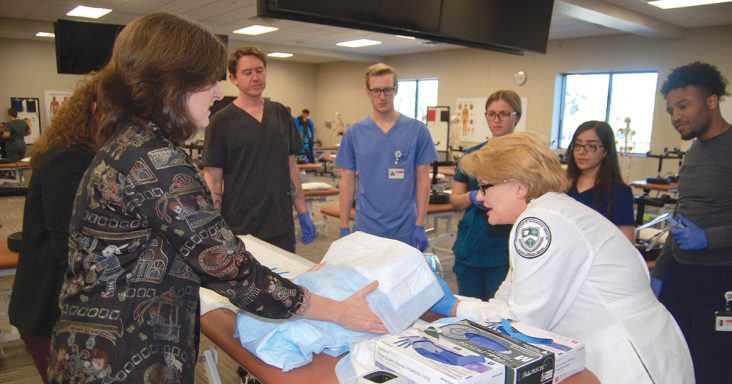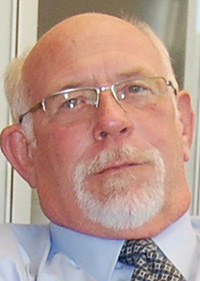Pie, other key events helped create the Arkansas Colleges of Health Education
by November 13, 2022 9:57 am 1,783 views

A professor with the Arkansas College of Osteopathic Medicine explains a medical procedure to medical students.
The answer to a question in 2013 over bourbon pecan pie at Hardscrabble Country Club in Fort Smith helped plant an idea. It would be one of five parts of what Kyle Parker calls a “wonderful, perfect storm” that created the Arkansas Colleges of Health Education (ACHE).
Parker, now the ACHE president and CEO, his mother Loretta, and Melody Trimble, former president of Sparks Health System, were wrapping up lunch.
“It was literally a happenstance moment. I said to Melody, ‘What would you do if you had a bunch of cash to make a difference in the community?” And she tells me without hesitation, ‘Oh, I’d build a DO [doctor of osteopathic medicine] medical school.”
Parker, who had started and sold a publicly held company selling legal documents and had a private banking and university management background, was puzzled by Trimble’s confident answer about a DO school.
“I literally knew nothing about DOs,” Parker said during a recent interview with the Northwest Arkansas Business Journal.
Prior to pie, there was a big sale.
Naples, Fla.-based Health Management Associates (HMA) in 2009 acquired Fort Smith-based Sparks Health System in a $138 million deal.
The Sparks Foundation, which would become the Degen Foundation, thought it might have about $2 million after it settled liabilities, pension obligations and other financial matters after the sale. But Parker, Jim Walcott, John Taylor, Judy Boreham Dawson and others affiliated with the former Sparks board began working to settle liabilities with the goal of having more than $2 million remaining to provide funding to meet medical needs in the region.
That effort would be another of the five parts of the perfect storm. With liabilities settled, the Fort Smith Regional Healthcare Foundation put funds for what would be ACHE into the Degen Foundation. The funds were restricted to be used only for a DO school.
“That $2 million became about $73 million. We ended up settling what was a few hundred liabilities for pennies on the dollar,” Parker said.
Indeed, the Degen Foundation reported total assets of $74.84 million — with all but around $9 million reserved for a DO school — as of June 30, 2015. They had “a bunch of cash.”
NEEDLE MOVES
During this time, Walcott, then the president of Weldon, Williams & Lick, challenged the others involved to do more than hand out a few grants. Taylor, Degen Foundation treasurer, said Walcott was almost demanding in his request that they not “nibble around the edges” and instead do something to “move the needle.” Walcott’s challenge came during a dark time in the region’s economic history.
The Fort Smith metro was just a few years removed from the June 2012 closure of Whirlpool’s Fort Smith manufacturing plant. The plant employed around 1,000 when it closed but had employed 4,500 at its peak. A University of Arkansas at Little Rock impact study indicated the region would see 6,610 jobs lost from the Whirlpool closure with an annual labor income loss of $256 million. Mitsubishi announced in 2012 that it would mothball its $100 million plant in Fort Smith. The plant, which never opened, was to employ between 400 and 500. As if that wasn’t enough bad news, the U.S. Air Force announced in early 2012 that the 188th Fighter Wing would lose its A-10 mission. At the time, the unit had about 350 full-time military members, with approximately 1,000 on the base monthly for training.
The needle had been moving but in the wrong direction. The Fort Smith metro peaked at 124,098 jobs in June 2006 and dropped to an annual monthly average of 112,881 in 2013 and a monthly average of 113,464 in 2014. Those were the two years Parker and others were considering Walcott’s challenge — the third of the five parts of the perfect storm — to move the needle by opening a DO school.

Parker said such negative news did not play into the decision. Still, a decision was made and announced in December 2013 to invest most of the funds held by Degen from the Fort Smith Regional Healthcare Foundation into the Arkansas College of Osteopathic Medicine (ARCOM). It would be the first college under the ACHE umbrella. As they continue to be, the key goals then were to alleviate a growing physician shortage and improve regional health and wellness.
BIG DONATIONS
Parker was named ACHE president and CEO in April 2014 — a job he initially and repeatedly rejected.
“I didn’t want this job,” he said. “I was happily retired. I was playing cowboy down on my ranch and was learning how to do stuff like welding. I had never been on a tractor in my life, but I was doing that and was really enjoying it.”
But Taylor and others wouldn’t let it go. Parker’s wife, Renee, said he should consider it.
“I talked to Renee, as one should do in any big decision like this. I told her startups are tough and that this would be a lot of long days and sacrifices. And she says, ‘I know, but you need to do this. You’ve always talked about giving back, so here you go,’” Parker said.
The remaining two of the five perfect storm elements happened in short order.
After ACHE broke ground in March 2015 on the $32.4 million, 102,000-square-foot main building, donations from anonymous sources began to roll in. As of October 2022, ACHE has received more than $155 million in donations since 2015 and has spent at least $220 million on land, facilities, equipment, a park, and residential and commercial buildings.
“That [donations] allowed us to build the health sciences building immediately. It allowed us to do the full renovation of the health and wellness center [former Golden Living building], and $14 million allowed us to put the best technology into this college,” Parker said.
Also, the late Ivy Owen, then executive director of the Fort Chaffee Redevelopment Authority, offered ACHE 200 acres of land. For free. It was part of what convinced ACHE to locate where it is now instead of other considered locations, including downtown Fort Smith.
“So yeah, what is that, five?” Parker responded when asked if the free land from FCRA was the last of perfect storm elements. “The land. Settling those liabilities, which was nothing short of a miracle. We had Jim’s [Walcott] message. … and the pie, the bourbon pecan pie. Of course, these family friends who believed in what we were trying to do and were just generous, just amazingly generous, and made those big donations.”
HEALTHY ENVIRONMENTS
Parker said getting all the pieces to come together relatively quickly not only allowed the college to become a reality but allowed ACHE to pursue several goals concurrently.
“It just allows you to explode. Yes, we’re an academic institution, but we’re also a developer. We’re building healthy living environments. We’re not just talking about health and wellness. We’re creating real, physical infrastructure and opportunities to encourage that,” he said.
The 200 acres of land is now 573 acres, with ACHE spending $6 million to buy adjacent property from the FCRA. ACHE also owns 63 acres with the Golden Living building purchase supported by a $32.3 million anonymous donation. The facility, now the ACHE Research Institute Health and Wellness Center, should be completely renovated in 2023.
The first class at the osteopathic college was seated in August 2017. ACHE has since built a $16 million, 66,000-square-foot College of Health Science building on the campus that is home to physical therapy and occupational therapy degree programs. The ACHE School of Physician Assistant Studies is under development. Commercial developments include a 78,131 square-foot, $22.5 million commercial building in the Heritage Village across the street from the college campus. That development was built upon an early $11 million, 6.6-acre commercial project that created Heritage Village in August 2018. Another development is the recently opened Celebration Garden and Wellness Park, funded by $2.3 million in private funds.
“New growth from the remnants of Sparks Health System describes the amazing progress of ARCOM,” Walcott said in a statement. “The superb match rate of graduates of the osteopathic medical program and the addition of other specialties means added high-quality capacity for healthcare providers in our region.
“Today, the River Valley has a wonderful new employer in ARCOM; in the future, the health of all the residents will improve with the added health care capacity and skill sets.”
According to Parker, the colleges now employ more than 200 staff and faculty with an average annual wage above $150,000. They now have more than 700 students on campus and will, within two to three years, have around 1,000 students in the different colleges and programs. Parker said the colleges and other programs are generating a $600 million annual economic impact for the region.
“ACHE, with its multiple schools culminating in terminal doctorate level degrees, hundreds of very bright students, thousands of square feet of beautiful buildings and hundreds of acres of land for development is the story that almost did not happen,” Taylor said in a statement to the Northwest Arkansas Business Journal. “Some would call it luck. We call it vision, perseverance, hard work, gifted leadership and providence.”
DIVERSITY, FUTURE PLANS
Parker said ACHE also has brought a diversified population to the Fort Smith metro, noting that “every color of skin, every religious belief, is right here in Fort Smith, Arkansas.”
“We have been pleasantly surprised how the community has accepted the highly diverse student body that we have out here. I’ll tell you one example. We had a foreign national student at a grocery store, and he was wearing an ACHE shirt. An older lady in front of him saw his shirt and bought his groceries,” Parker said.
Parker expressed frustration that not enough people fully understand “the holistic nature of wellness and education and arts.”
“Will they eventually understand? Yes. It takes time. I don’t think I’m beating my head against a wall on this,” he said.
The disappointments are not a detriment. Parker, Taylor, Walcott and other ACHE officials aren’t finished. Come back in five years, and up to eight others will join the four academic buildings now on campus.
Parker teased that “two major programs” will be announced in early 2023. He also said that in 10 years, the campus could be home to 6,000 post-graduate students. They are also in talks to build a boutique hotel on the campus.
The expanding campus in the region helps with other economic development projects, according to Tim Allen, president and CEO of the Fort Smith Regional Chamber of Commerce.
“Having a resource like Arkansas Colleges of Health Education in our community is invaluable,” Allen noted. “In terms of economic development, we showcase ACHE to every single prospect, and it makes a real difference. The wealth of talent, knowledge and resources that ACHE brings to the Fort Smith region helps us sell our quality of place. And more often than not, that’s what wins a project for the community.”
Wrapping up his thoughts at the end of a recent interview, Parker said he does not take for granted what many people have been able to do in just a few years.
“That’s pretty rare, even for business guys, to move at the kind of speed that we have. And the only way to accomplish that is to have a great team of people, and I mean a really great team of people,” Parker said. “The other thing is when you’re doing things for somebody else when it’s not for you, great things happen.”
